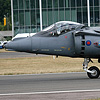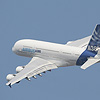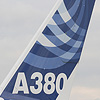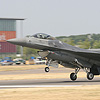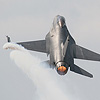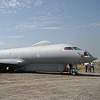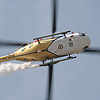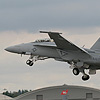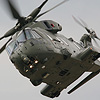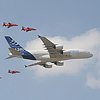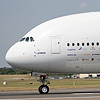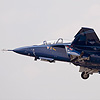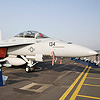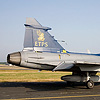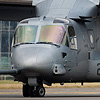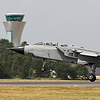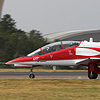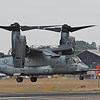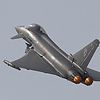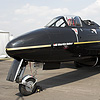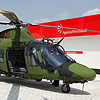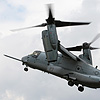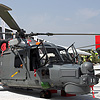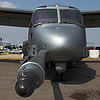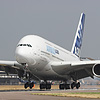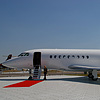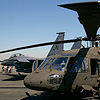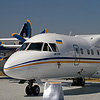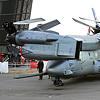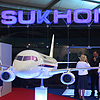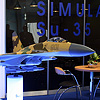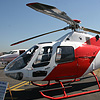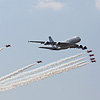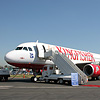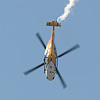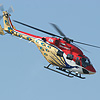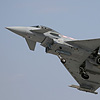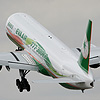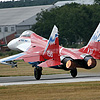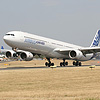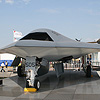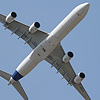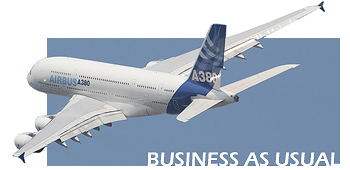
Farnborough International Airshow 2006 Review
Monday 17th July - Sunday 23rd July
Farnborough is the longest running Airshow in the UK, dating back to 1948. Held every two years, alternating with Paris, Farnborough is primarily a trade show, where billions of pounds of business are done throughout the weekday trade days. By the weekend the show is ready to open its doors to the Public. Farnborough has a long-standing tradition of giving new and exciting types their UK debuts. In 2006, this trend continued.
visited Farnborough International 2006 for UK Airshow Review. Additional photography from , , , , and .
It had almost become inevitable, prior to the show, that Airbus would send their newest aircraft, the enormous and hugely impressive A380. It was, therefore, little surprise when it was added to the participation list a few months before. This was only the second time an A380 had appeared in the UK, with an example visiting Heathrow and various Airbus sites around the country only a couple of months before.
Also making its UK debut was the Bell/Boeing MV-22B Osprey. As seen the previous week at RIAT, Bell/Boeing are obviously keen to market the aircraft, confident that its lengthy development problems are a thing of the past. The increased tactical opportunities and flexibility this aircraft will give its operators cannot be overlooked, and as such, the RAF and Royal Navy have been touted as potential export customers, along with a few other nations. With this in mind, it was not unexpected that two USMC MV-22Bs from VMX-22 at MCAS New River, North Carolina showed up at both RIAT and FI. Having self-deployed across the Atlantic with the help of a Marine Corps KC-130, despite one having a problem en route and diverting to Keflavik in Iceland, both eventually arrived safely.
The Osprey demonstration was flown by Bell/Boeing test pilots and showed off the aircrafts ability to transform into a fixed wing aircraft from a helicopter, demonstrating that it can perform the transformation seamlessly. It's certainly unconventional and a very impressive sight.
Hindustan Aeronautics (HAL) of India gave their new "advanced" jet trainer, the Intermediate Jet Trainer HJT-36, its debut. With an engine that seemed about as powerful as a Vidal Sassoon hairdryer, the poor little jet struggled to get into the air for its display, using an alarmingly unhealthy amount of runway. After a brief and uncharismatic showing of rolls and loops, you could almost hear the sighs of relief amongst the crowd as the aircraft lined up on finals to end its display. Whilst HAL are apparently re-engineing the production aircraft, it doesn't take a rocket scientist to see why. As an indigenous aircraft, its development must be encouraged, but it's impossible to see it taking any orders off the Hawk and M346 if it is marketed against them. HAL's Dhruv helicopter which followed put on a much more sprightly display.
With the exception of a stand in one of the Exhibition Halls, OKB Sukhoi once again sent no aircraft to FI. Such a shame, as their fabulous Flanker series of fighters have often been the stars of FI in the past. In actual fact, the last time Sukhoi sent a flying aircraft was at FI 2000 in the shape of an Su-32. It was a bit unexpected; particularly with a healthy order book for versions of the Su-30 at the moment, that Sukhoi did not take advantage of the opportunity to further promote the aircraft at FI 2006.
For the public days, RAF displays were brought in. Team Merlin and the Chinook display both performed, putting on great shows as we all expect. Team Merlin Manager Gareth Attridge's plug for UKAR during his commentary was, of course, appreciated! RAF Typhoon, Tornado GR.4 and Harrier also displayed, along with the Red Arrows.
Then, of course, there is RSK MiG's MiG-29OVT (aka MiG-35), which is currently a contender for India's MRCA (Multi-Role Combat Aircraft) requirement. This is quite possibly the last incarnation of MiG's highly successful Fulcrum series. The aircraft offers a true multi-role capability, thrust vectored engine nozzles (capable of moving 15 degrees in any direction), a modified digital fly-by-wire flight-control system and an AESA radar.
It's hard to put into words just how incredible the MiG is, with its thrust-vectored nozzles in action. A breathtaking display of agility, the most noticeable manoeuvres being when the aircraft hovered for a number of seconds whilst in a high angle of attack position, being able to loop pretty much within it's own dimensions and perform a Super Cobra. Whilst there is a chance that the latest generation of thrust vectored Flankers and the F-22 Raptor can match it for agility, it's unlikely that any of the latest European fighters can even come close. However, it's unclear if thrust vectoring offers any significant advantage in combat, but the Russians and Americans obviously believe it does.
Despite its basic design being over thirty years old, the Lockheed Martin F-16 is still a regular performer at FI. With the aircraft still selling well thanks to upgrades and modifications, Lockheed Martin certainly feel the design has more to offer. At the hands of an LM test pilot the Viper (in this case an F-16CJ from Spangdahlem) once again showed off its power and agility, with an energetic routine with the aircraft rarely straying from crowd centre for long. It's unclear what versions of the Viper LM are still offering, but most likely it's Block 50/52/60 aircraft, with a probable emphasis on the latter to capitalise on the United Arab Emirates F-16E/F Block 60 order.
Boeing sent two F/A-18F Super Hornets from the US Navy's VFA-122. Whilst the production lines at St. Louis are full with a large order from the US Navy; the aircraft has yet amazingly to secure a single export order. Incidentally, it is another contender for the Indian MRCA requirement alongside the MiG-29OVT and F-16. Once again Chief Super Hornet Test Pilot Ricardo Traven was displaying the aircraft. With every move, Traven pushed the aircraft to the very edge of its impressive performance envelope, with a superb display. This year, Traven displayed the Super Hornet clean, without dummy AIM-120s and AIM-9s as he did back in 2004, although it was difficult to recognise any difference in the aircrafts performance; consider this a tribute to its power and natural agility.
BAE Systems made more of an effort to support the flying display this time around, with a Nimrod MRA.4A doing a flyby on some of the days. BAE Systems also finally announced the contract with the RAF to supply 12 MRA.4A's at the show. Additionally, BAE Systems sent Eurofighter Typhoon IPA1, sporting six dummy GBU-16s, a centreline droptank, four AMRAAMs and two Sidewinders, to display on a couple of the trade days.
Saab also weren't to miss out in the battle of the fighter at FI and sent a Gripen to display. The Gripen put on a good showing, a type that is seldom seen at UK shows these days. Saab are looking to profit from their export success orders from Hungary, Czech Republic and South Africa and believe the Gripen is an affordable and multi-role solution to many nations defence problems. The aircraft is yet another MRCA contender.
Despite the delays, the Airbus A380 is expected to enter airline service next year; a mere two years after it first flew. This is an impressive feat for any new aircraft, but especially one as large and complex as the A380. Displaying just after the A340-600 and also flying a similar routine, both aircraft put on incredible shows for their size and weight. A particularly noticeable part of both displays was the high-alpha pass, quite phenomenal to see airliners doing something that is usually solely attributed to the fighter world. The A380, affectionately dubbed “Slaphead” by UKAR members, won't ever be short of critics and needs more orders for the project to break even at the time of writing. Nevertheless, it certainly gained many admirers at FI; an aircraft Airbus has every right to be very proud of it.
Before the flying starts there is plenty to see and do. The large exhibition halls are certainly worth a visit, even if you're only after freebies, such as aircraft posters, keyrings, note pads etc. The EADS and Airbus stands were particularly generous in this respect. There are literally hundreds of different aerospace manufacturers on show. If you're intent on seeing it all you could probably spend the best part of the day going around the exhibition halls alone.
Sadly some of Farnborough's old problems reared their ugly heads again. The aircraft being restricted to display at comparatively high altitudes and distant compared to other UK shows and also FI's miraculous knack of items vanishing just prior to the public show days - the RAF Sentinel R.1 and Kingfisher A320 being two of the more noticeable culprits. I remember when a RAH-66 Commanche did a similar thing at FI '98, so frustrating!
There's no doubt Farnborough International 2006 was a good show. It's never going to be RIAT, but nor does it set out to be. The RIAT/Farnborough "partnership" of swapping participants certainly helped both shows once again; hopefully this is something that can be maintained and built on in future years.
So now that FI 2006 is a distant memory, what can we expect from FI 2008? Although there may not be too many different aircraft types from this year's show, the likes of the Lockheed Martin F-22 Raptor and Boeing 787 are certainly possibilities and give plenty of food for thought!

